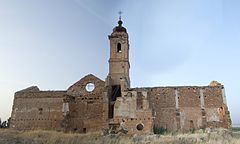 | ||
Similar | ||
The Monasterio de Santa María de la Trapa de Santa Susana, known simply as Trapa de Santa Susana or La Trapa by local people, is a ruined monastery located close to road A-1411 north of Maella, close to Favara del Matarranya in Aragon, Spain.
The monastery falls within Maella municipal term, in what used to be known as Priorat de Santa Susanna de Maella, Spanish: Priorato de Santa Susana de Maella.
The monastery passed through periods of splendor and decadence throughout its existence and is now in ruins.
History
The original monastery was established in the 6th century by Benedictine monks who, at some point in its first 600 years, rebuilt it with the help of the Order of Calatrava. This monastery was transferred by James I of Aragon to the Cistercian Order in 1227.
The Cistercians destroyed the former building to erect a new one. In the 16th century, Miguel Pérez d'Almazán, Lord of Maella, tried to establish a village close to the Monastery under the name Villanueva d'Almazán, but his project failed.
At the time of the French Revolution, some French Trappist monks were welcome in the monastery and a thriving Trappist community became established in what became known as Trapa de Santa Susana. Despite the ravages caused by the Peninsular War, this community of monks flourished until the mid 19th century, when the Ecclesiastical Confiscations of Mendizábal La Desamortización caused the exclaustration of the monks and brought monastic life to an end.
According to local tradition the monastery is named thus because, at some point in its history, it had housed the mortal remains of Saint Susanna, known locally as "Virgen de Levante", the 'Levantine Virgin'.
The ruins are located by themselves on one side of the road and the graceful bell tower is very conspicuous in the relatively desolate landscape. There are some farm buildings on the other side of the road.
